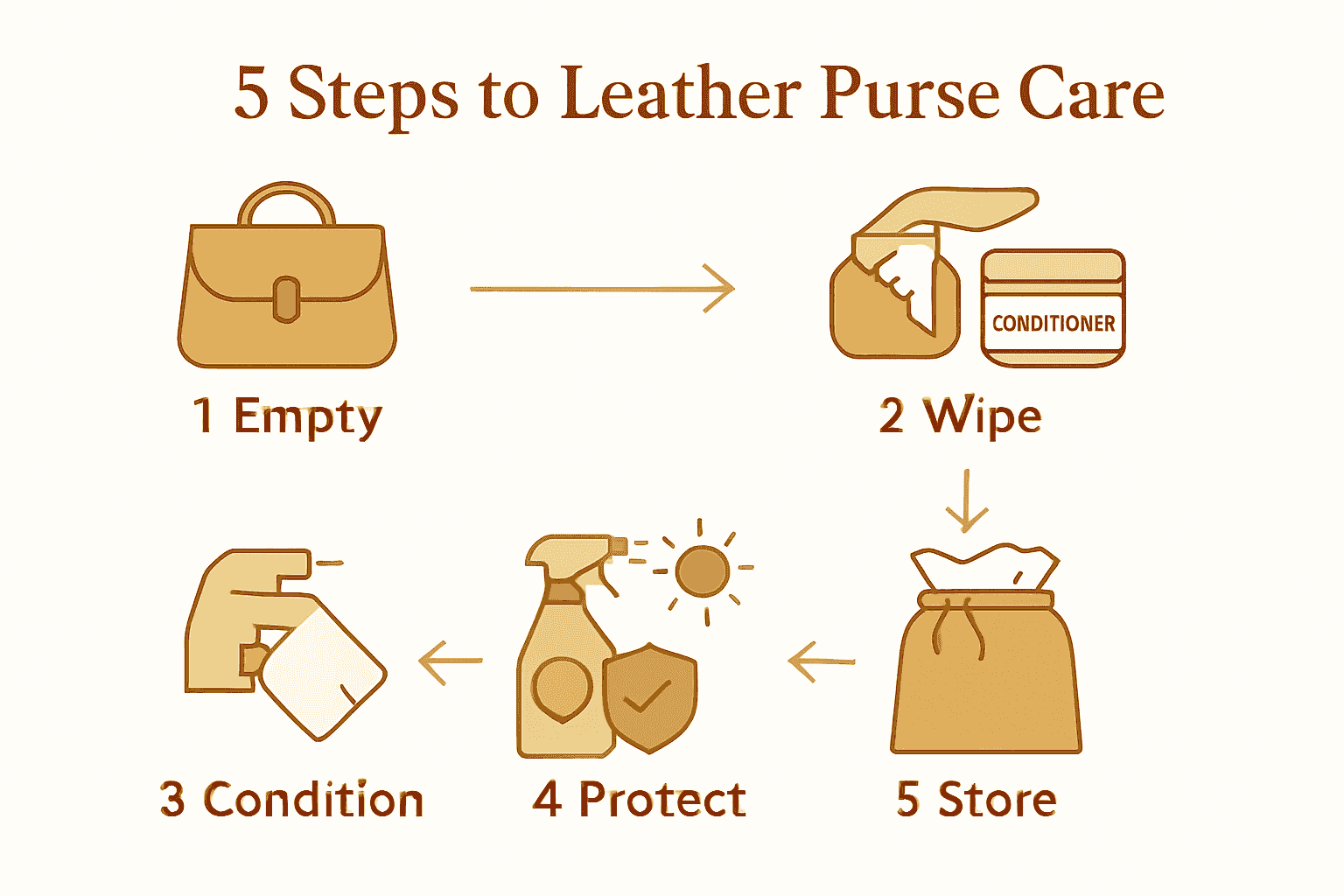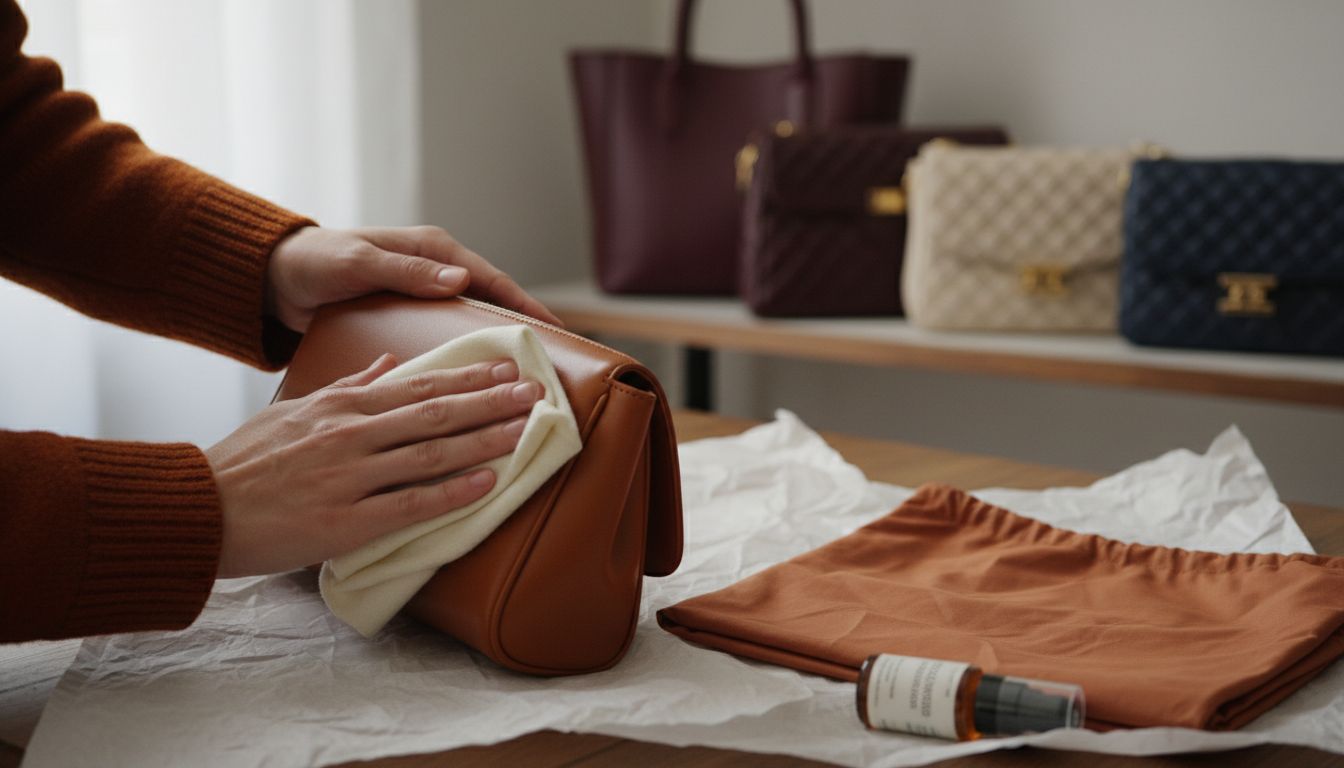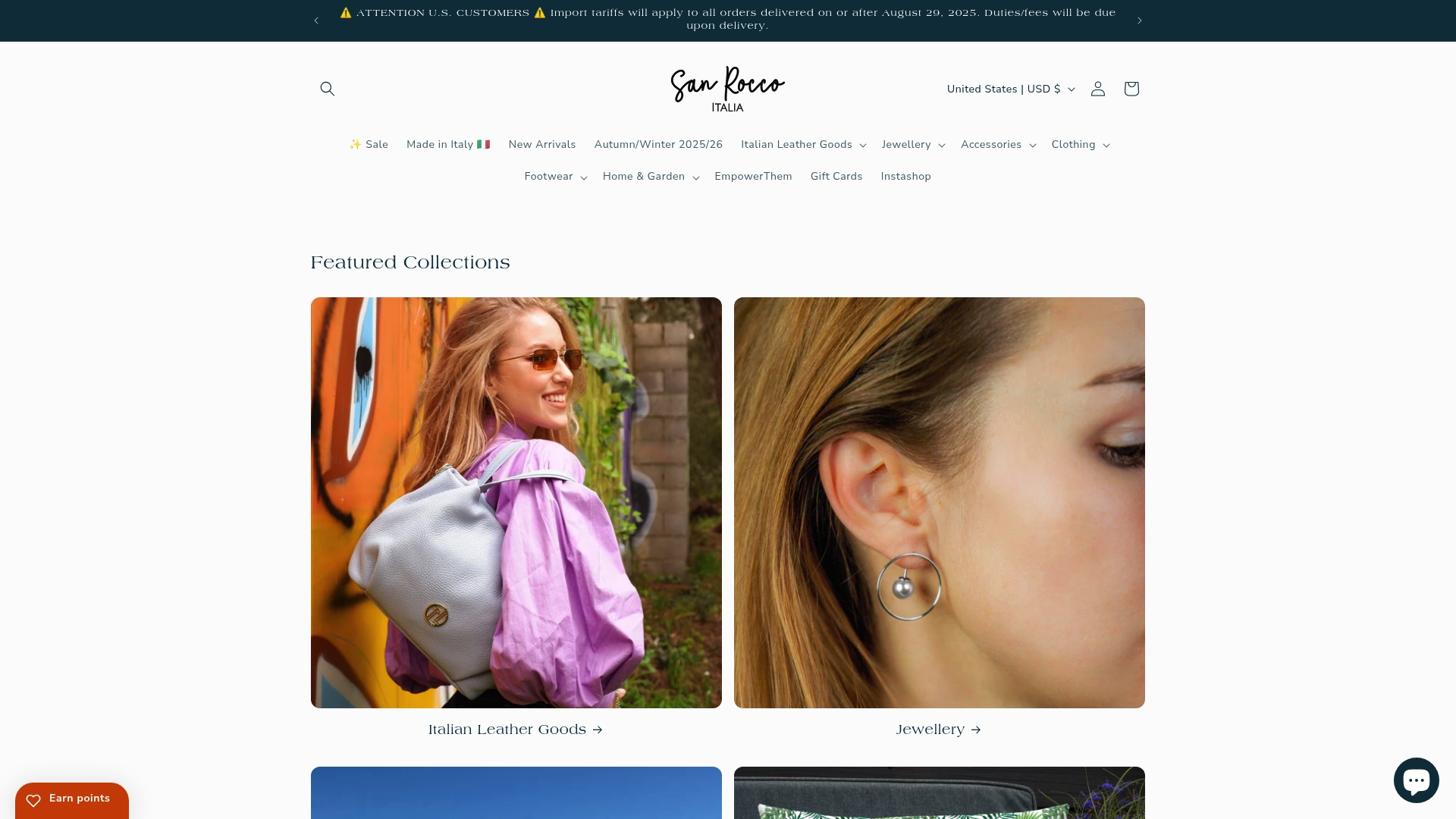
How to Care for Leather Purse: Preserve Italian Luxury
Share
A well crafted Italian leather purse can last for years, but even the finest british care routines sometimes overlook the basics. Studies show that nearly 60 percent of luxury handbag damage happens because of improper cleaning and storage. Protecting your leather purse starts with understanding the safest steps for cleaning, conditioning, and storing it. This practical guide will help you keep your treasured accessory looking polished while avoiding costly mistakes.
Table of Contents
- Step 1: Prepare Your Leather Purse For Cleaning
- Step 2: Clean The Surface With Gentle Methods
- Step 3: Condition The Leather For Lasting Suppleness
- Step 4: Protect Your Purse From Everyday Hazards
- Step 5: Store Your Leather Purse Correctly
Quick Summary
| Key Insight | Explanation |
|---|---|
| 1. Thoroughly empty your purse | Always remove all contents before cleaning to prevent damage and ensure thorough access to clean surfaces. |
| 2. Use gentle cleaning methods | Employ a soft, lint-free cloth and mild soap solution to avoid damaging the leather during cleaning. |
| 3. Condition regularly for softness | Use a quality leather conditioner to maintain suppleness and prevent cracking, applying it evenly in circular motions. |
| 4. Protect from environmental hazards | Apply a leather water repellent and store away from direct sunlight to guard against moisture and fading. |
| 5. Store in breathable bags | Use acid-free tissue paper and a breathable cloth bag to preserve shape and protect against dust and damage. |

Step 1: Prepare your leather purse for cleaning
Preparing your Italian leather purse for cleaning is a crucial first step that sets the foundation for an effective and gentle maintenance process. Proper preparation helps protect your precious accessory and ensures you achieve the best possible cleaning results without risking damage to the delicate leather surface.
According to bestleather.org, the initial phase involves a careful and methodical approach. Begin by completely emptying your purse, removing all contents from internal pockets and compartments. This step prevents potential damage to items inside and allows you unrestricted access to clean every surface thoroughly. Next, take a soft, non abrasive, lint free cloth and gently dust the entire exterior of the purse. Use light, sweeping motions to eliminate surface dirt and loose debris, which can potentially scratch the leather during deeper cleaning.
Be particularly attentive around seams, corners, and hardware where dust and grime tend to accumulate. A microfibre cloth works exceptionally well for this initial preparation stage, as it effectively traps particles without introducing additional moisture or friction. By investing a few minutes in this careful preliminary process, you will set yourself up for a successful and safe leather purse cleaning experience.

For those working with white or light coloured leather purses, consider our detailed guide on white leather maintenance to ensure you approach the cleaning process with the utmost precision.
Step 2: Clean the surface with gentle methods
Cleaning the surface of your Italian leather purse requires a delicate touch and strategic approach to maintain its luxurious appearance and protect its premium quality. The goal is to remove surface dirt and grime without compromising the leather’s natural beauty or structural integrity.
Bestleather.org recommends a gentle cleaning method that prioritises the preservation of your leather accessory. Start by selecting a soft, non abrasive, lint free cloth that will not scratch or damage the leather surface. Gently wipe the entire exterior of the purse using light, sweeping motions to remove dust and superficial dirt. Avoid aggressive rubbing or applying excessive pressure, which could potentially mar the leather’s finish.
For slightly more stubborn dirt, bestleather.org suggests using a soft cloth very lightly dampened with a mild soap and water solution. The key is moderation minimal moisture is crucial. Ensure the cloth is merely damp, not wet, and test the solution on a small, inconspicuous area first to verify it does not cause discolouration or damage. After cleaning, use a dry microfibre cloth to immediately absorb any remaining moisture, preventing water spots or potential leather damage.
Remember that different leather types may require slightly varied approaches. Our comprehensive guide on white leather maintenance offers specialised insights for lighter coloured leather accessories, ensuring you can clean your purse with confidence and precision.
Step 3: Condition the leather for lasting suppleness
Conditioning your Italian leather purse is a critical step in preserving its luxurious texture, preventing premature ageing, and maintaining its elegant appearance. This process helps protect the leather from drying, cracking, and environmental damage while ensuring your treasured accessory remains soft and supple for years to come.
Bestleather.org offers expert guidance on conditioning leather accessories. Begin by selecting a high quality leather conditioner specifically designed for premium leather goods. Using a clean, soft cloth, apply a small amount of conditioner and work it into the leather using gentle, circular motions. The key is to apply the product sparingly too much conditioner can oversaturate the leather and potentially damage its natural properties.
According to bestleather.org, it is crucial to ensure even coverage across the entire surface of your purse. Pay special attention to areas that experience more friction or exposure, such as handles and corners. After application, allow the conditioner to absorb for a few minutes, then use a clean, dry cloth to remove any excess product.
Pro tip: Always test the leather conditioner on a small, inconspicuous area first to ensure compatibility with your specific leather type. If you have a white or light coloured leather purse, our specialised white leather maintenance guide offers additional tailored advice for maintaining its pristine appearance.
Step 4: Protect your purse from everyday hazards
Protecting your exquisite Italian leather purse from daily wear and potential damage requires a proactive and thoughtful approach. By understanding and implementing strategic protective measures, you can significantly extend the lifespan and maintain the pristine condition of your treasured accessory.
Bestleather.org recommends several crucial strategies to shield your leather purse from environmental threats. One primary consideration is safeguarding against water damage by applying a specialised leather water repellent spray. This protective barrier helps prevent moisture absorption that could potentially compromise the leather’s integrity. Additionally, be mindful of your purse’s exposure to environmental conditions direct sunlight and excessive heat can cause irreversible damage, leading to premature fading and structural weakening.
According to bestleather.org, storing your purse correctly is fundamental to its preservation. Always choose a cool, dry storage location away from direct heat sources and intense sunlight. When not in use, consider storing your purse in a breathable dust bag or cotton pillowcase to protect it from dust and potential scratches. Avoid hanging your purse by its straps, as this can cause unnecessary strain and distortion of the leather’s natural shape.
For those with lighter coloured leather accessories, our comprehensive white leather maintenance guide offers additional specialised protection insights to keep your purse looking immaculate.
Step 5: Store your leather purse correctly
Proper storage is a critical aspect of maintaining your Italian leather purse’s pristine condition and ensuring its longevity. By implementing strategic storage techniques, you can protect your investment and preserve its exquisite appearance for years to come.
Bestleather.org offers expert guidance on leather purse preservation. Begin by selecting a breathable cloth bag specifically designed for leather accessories. This allows the leather to maintain proper air circulation while protecting it from dust and potential environmental damage. When storing your purse, carefully stuff it with acid free tissue paper to help maintain its original shape and prevent unsightly wrinkles or structural deformation.
According to bestleather.org, the ideal storage environment is crucial. Choose a cool, dry location away from direct sunlight and extreme temperature fluctuations. If possible, store your purse in its original box, which provides additional protection. When positioning the bag, ensure it is not compressed or placed under heavy items that could distort its shape. Our comprehensive guide on leather handbag storage offers additional insights into creating the perfect preservation environment for your cherished accessory.
Preserve the Elegance of Your Italian Leather Purse with San Rocco Italia
Caring for your luxury leather purse requires more than just occasional cleaning. You face challenges like protecting your handbag from water damage, preventing premature ageing and preserving that supple texture that defines true Italian craftsmanship. Our article’s step-by-step guide highlights the importance of gentle cleaning, conditioning and proper storage to maintain your purse’s pristine condition. At San Rocco Italia you can discover exquisitely crafted leather goods made in Italy, designed to be both timeless and durable so you don’t have to worry about frequent replacements.

Experience the difference true craftsmanship makes by exploring our collection of luxury handbags and accessories with premium full-grain leather. Treat yourself to a handbag that embodies elegance and longevity while preserving the sophisticated style you deserve. Begin your journey to exceptional leather care and style today at San Rocco Italia. Discover expert advice on caring for your investment, and elevate your collection with pieces designed to last a lifetime. Shop now and protect your purse with quality that speaks for itself.
Frequently Asked Questions
How do I prepare my leather purse for cleaning?
To prepare your leather purse for cleaning, start by completely emptying it of all contents. Use a soft, non-abrasive, lint-free cloth to gently dust the exterior and remove surface dirt. This initial step protects your purse from potential scratches during deeper cleaning.
What gentle methods can I use to clean my leather purse?
Use a soft, lint-free cloth to gently wipe the exterior of your leather purse in light, sweeping motions. For more stubborn dirt, dampen the cloth with a mild soap and water solution, testing it on a small area first to ensure it doesn’t cause discolouration. Avoid aggressive rubbing to preserve the leather’s finish.
How often should I condition my leather purse?
Condition your leather purse every 3 to 6 months to maintain its suppleness and prevent drying or cracking. Apply a small amount of high-quality leather conditioner with a soft cloth, using gentle circular motions for even coverage.
What protective measures should I take to safeguard my leather purse?
Apply a specialised leather water repellent spray to protect against moisture damage, and store your purse in a cool, dry place away from direct sunlight and heat. Additionally, consider using a breathable dust bag for storage to prevent scratches and dust accumulation.
How should I store my leather purse to preserve its condition?
Store your leather purse in a breathable cloth bag or its original box to allow air circulation. Stuff the purse gently with acid-free tissue paper to maintain its shape, ensuring it is not compressed or placed under heavy items that could distort it.
Can I use household products to clean my leather purse?
It’s best to avoid using household products not specifically designed for leather care, as they may damage the material. Instead, stick to a mild soap and water solution for cleaning and a quality leather conditioner to maintain its appearance. Always test any new product on a small, inconspicuous area first.
Recommended
- How Can I Clean a Leather Purse Naturally and Effectively? – San Rocco Italia
- 7 Expert Tips for Choosing Nice Leather Purses That Last – San Rocco Italia
- How Do I Clean a White Leather Purse Safely and Effectively – San Rocco Italia
- 8 Best Italian Leather Handbags Made in Italy to Explore – San Rocco Italia


